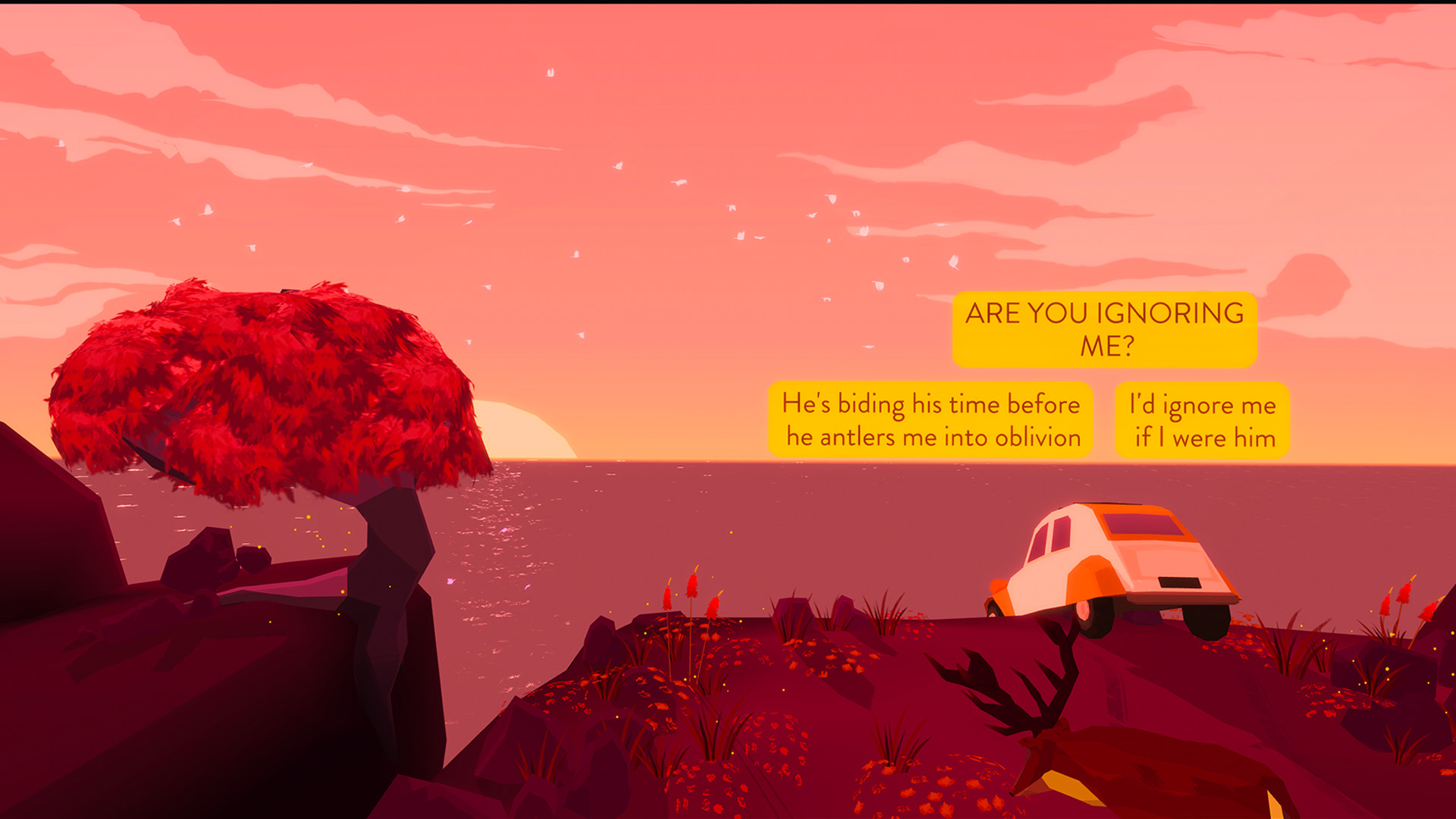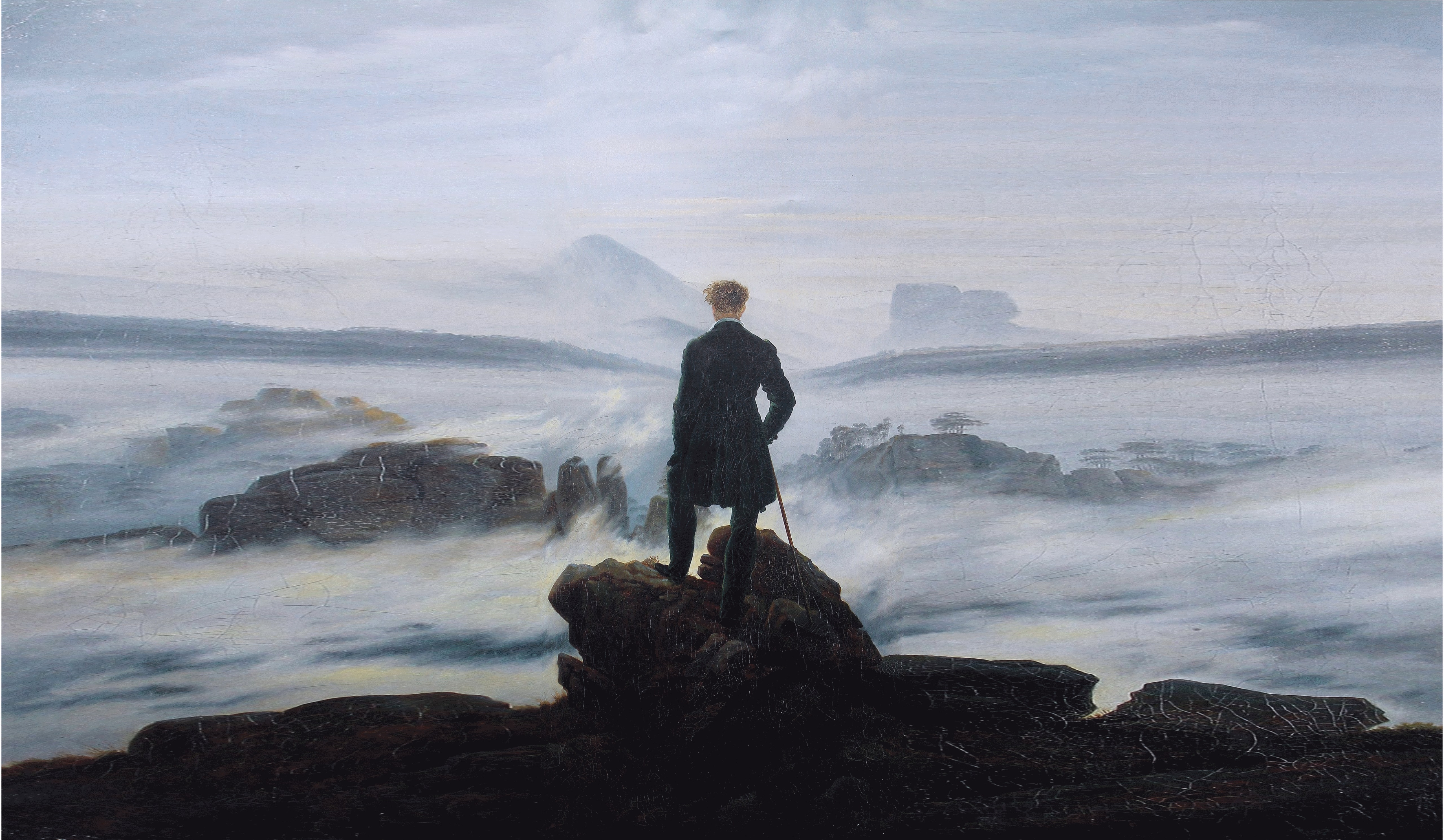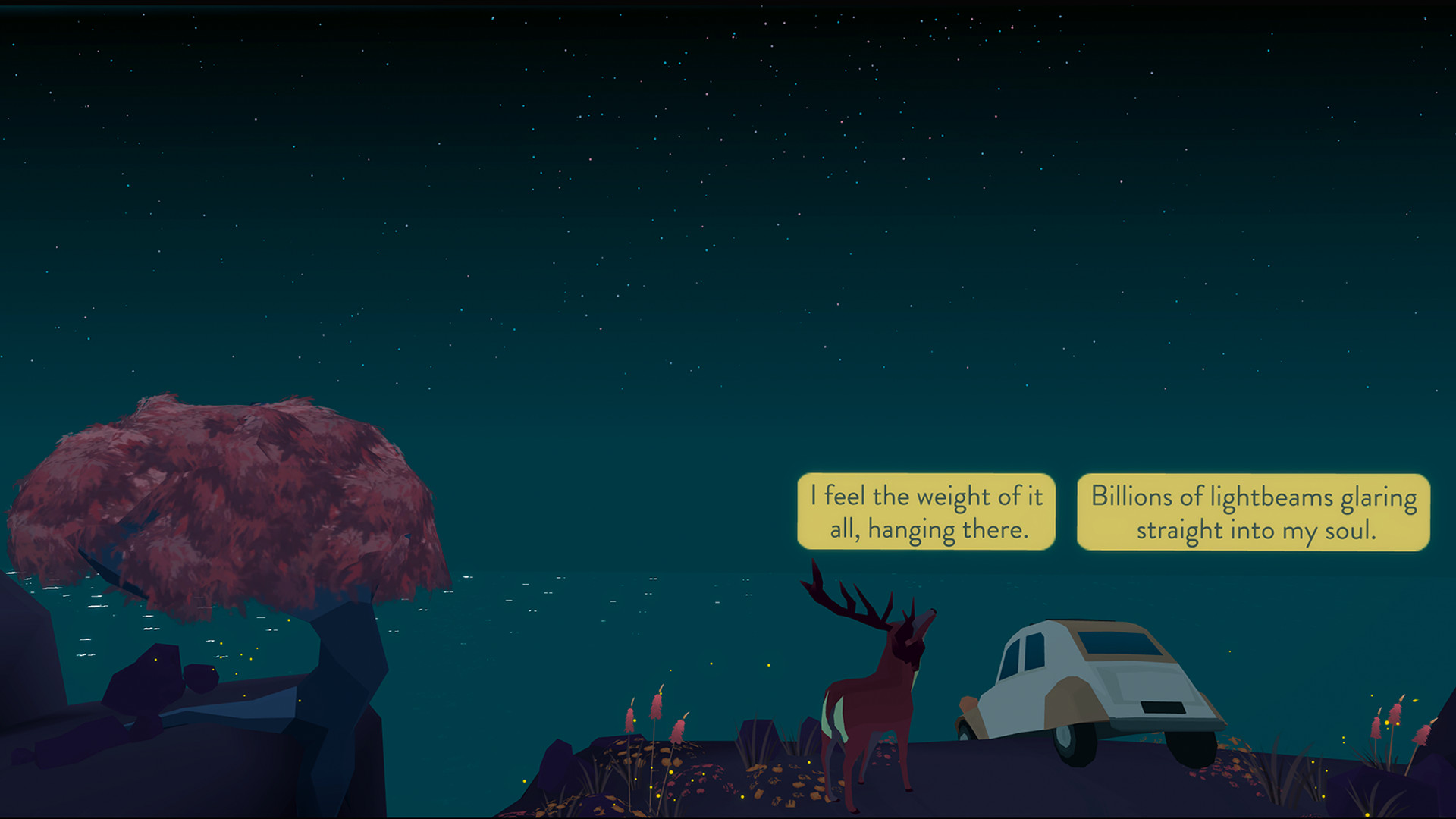Imagine jumping into your car, leaving the stresses of civilization and escaping to the quiet embrace of nature. I think many of us have had this idea. Fleeing to the countryside to then have your car balancing on the edge of a cliff, not so much. However, this is the fate of the main character in George Batchelor’s game Far From Noise. She has left the city and driven to the cliffs to clear her head, but managed to get herself into an unfortunate situation.
The car’s engine has flooded, meaning that she must wait all night for it to recover. As her fate hangs in the balance, she begins to question parts of her life and decisions she’s made. Just when things couldn’t get any more alarming, a deer wanders up to the car and starts talking to her. Trying to calm her down.
After accepting that she is either speaking with a spiritual entity or has gone a little insane, the two talk. Throughout the night they philosophize about creativity, existence, perspective, nature, life, death, and everything in between.
Waxing Philosophical on the Edge
Far from Noise captures a unique and intimate perspective on nature and our connection to it. It borrows ideas stemming from romantic landscape art and transcendentalist thinking. It’s a quietly beautiful game that explores the middle ground of being terrified and awe-inspired by the power of nature.

The only silver lining to her situation is that the view from the cliff is absolutely beautiful. It’s quiet and peaceful here. As the sun sets the landscape turns amazing shades of pink and orange. The woman is suspended between her fear of life’s abrupt conclusion and her awe of nature’s sublime and gentle moments: the sound of the sea, the wind rustling through the trees, butterflies, birds, and badgers.
At one point in the game there is a ferocious storm that rages across the landscape. Even though it could mean a critical end to the woman, she comments on how sensational it was. As the game continues, she constantly fluctuates between intense feelings of terror or tranquility accompanied by the player. As you begin to relax into the game’s pretty visuals and ambient soundtrack, the car rocks just a smidge too far. Suddenly you snap right back into tension.
Romantic Notions of Escape
Romantic landscape art takes this approach to nature and makes the most appropriate comparison to Far from Noise. Probably the most famous romantic piece of artwork is Caspar David Friedrich’s Wanderer above the Sea of Fog. The painting shows the image of a dapper man looking out into the landscape. Just like our protagonist, the romantics wanted to escape back to nature. They viewed nature as a pure and spiritual source of tranquility and restoration, away from the smoggy fumes of industrialization.
In both composition and topic matter Far from Noise and Wanderer above the Sea of Fog are very similar. Both the woman in the car and the wanderer in the painting are looking out into the landscape, their back to the viewer. We cannot tell if either of our characters are terrified, exhilarated or both by what they are facing. In the game there are these long pauses where it’s difficult to tell whether they are pauses of dread or calm.

In the face of profound power and beauty, both figures reveal their relationship to nature in different ways. Friedrich’s figure is proudly prominent within the painting, his stature is dominant and powerful as he rests his foot subtly on top of a rock whilst gazing into the horizon. He shares his view with no one and embodies the image of a lonely wanderer. Fog hides the landscape from our eyes. All we can see are several large rocks jutting through the mist.
In Far From Noise the landscape is vastly different. Our protagonist faces a more relaxing and ambient scene, despite the obvious danger. The ocean is calm and empty: a tranquil space for thought and reflection. In addition, whilst the woman comments that she a spectator, “looking AT something”, as she continues her chats with her philosophical friend. Through transcendentalist thinking, we see that the woman shares her horizon and is actively a part of it.
Transcending the Physical
Transcendentalism focuses on the embrace of spiritual identity, personal freedom and one’s connection to nature. Developed in the 1800s, the movement focused on the idea that individuals had become corrupted by society and material wealth. To correct this they should strive to retain independence in terms of identity and freedom.
Our protagonist encompasses this very problem, she talks about not feeling accepted and feeling like she is in a loop of disappointment. Being on the brink of death causes her to question herself but the landscape also prompts certain questions within her. When faced with something so profound it’s easy to think that you are inconsequential, but I think that Far from Noise is saying that this feeling is valid.
In these times escaping to nature and taking your time to figure ‘it’ out can be comforting. I don’t think the game is making any grand statements about life and death but its thoughtful reflections make you participate and think. As our companion points out: this cliff is “one such place to watch the world go by.” It is a stage to witness the harmony of life and this includes death.

Embracing Ourselves (and Others)
Far from Noise lulls you into a place of thoughtful reflection. The tranquility of the sunset, the soothing tones of the ocean and the gentle wind are all peaceful and sublime. Escaping to nature, away from the noisy and busy bustle of civilization, has calmed the soul (as our antlered friend would describe it). As the day turns to night you stargaze with your deer friend. For a time it’s possible to forgot all about the cliff and your potentially imminent death. Instead you’re comforted with friendly conversation and calming ambiance.
Far from Noise is a unique, deeply thoughtful and beautiful game. However, it is foundationally different from the ideals of both Romanticism and Transcendentalism. Romanticism and Transcendentalism focus on an individual being alone on their journey. Far from Noise demonstrates that converstaions between people (or talking animals) can also be a way of finding answers to our questions.
What might have happened to our protagonist if she’d been left alone with her thoughts? Far from Noise emphasizes that our connection to other people, friends or strangers, is essential for growth and reflection.



